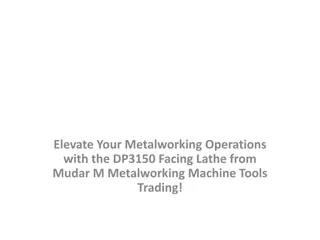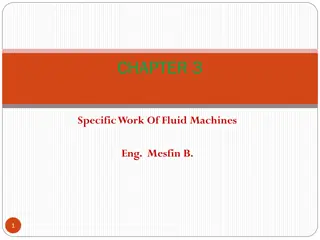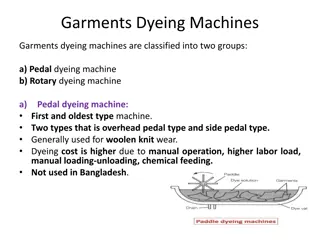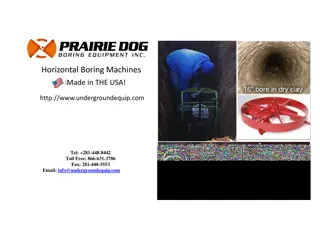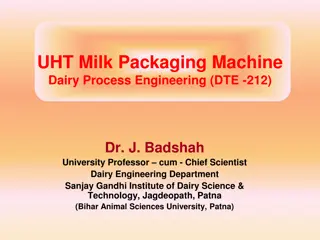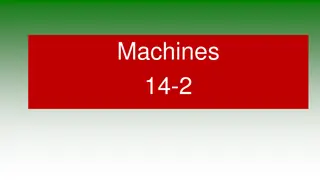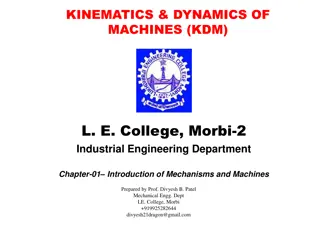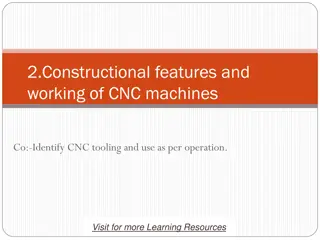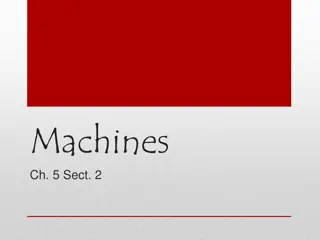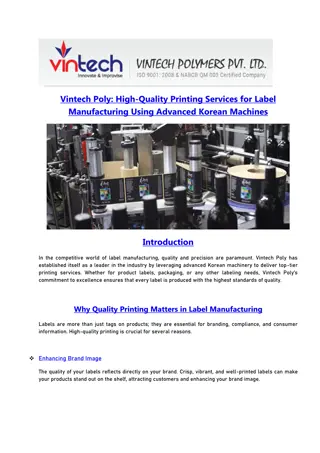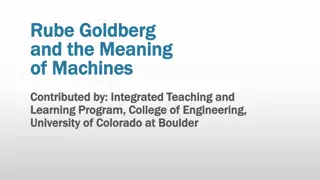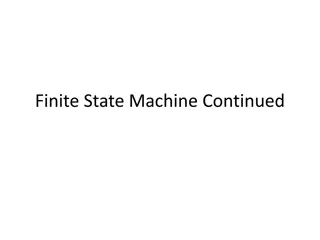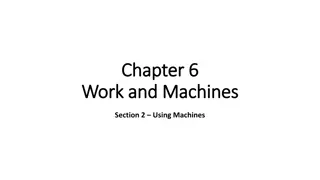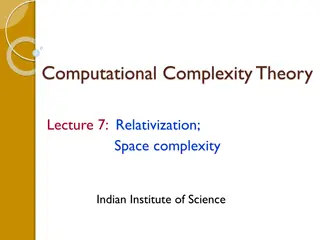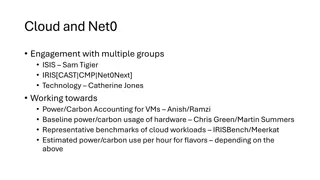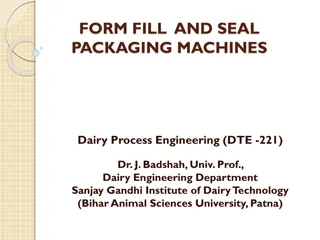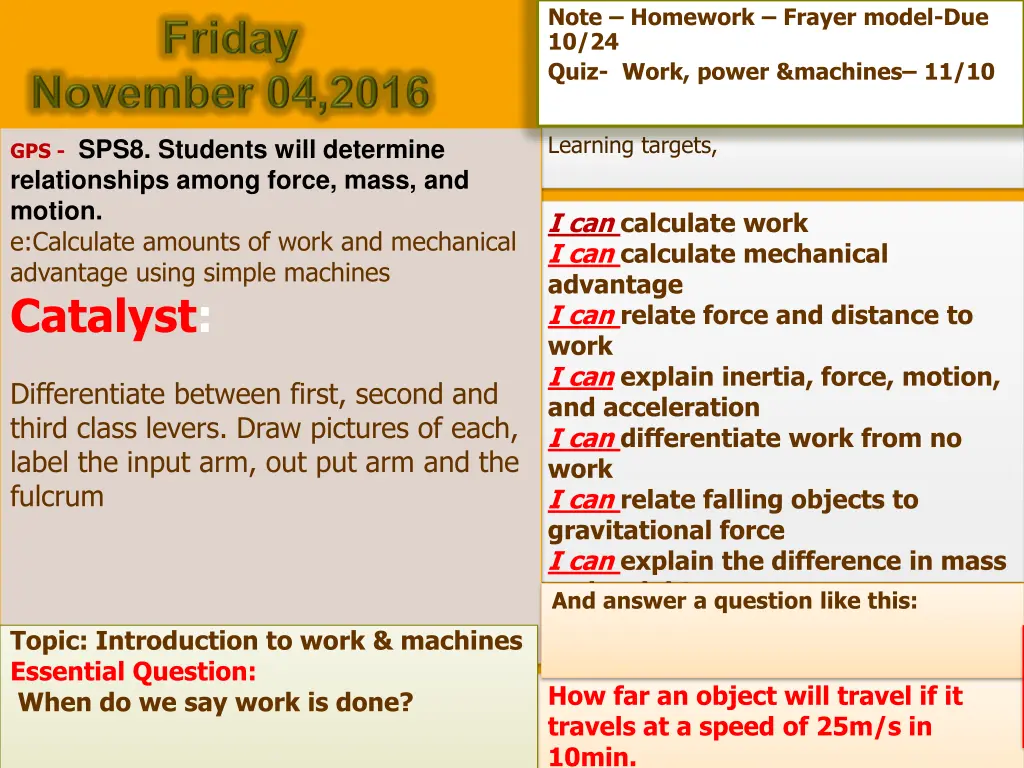
Understanding Work, Power, and Machines in Physical Science
Explore the concepts of work, power, and machines in physical science through the relationships among force, mass, and motion. Learn how to calculate work and mechanical advantage using simple machines, differentiate between different levers, and understand the essential question of when work is considered done. Dive into topics like force, inertia, motion, acceleration, and gravitational force to deepen your understanding of these fundamental physics principles.
Download Presentation

Please find below an Image/Link to download the presentation.
The content on the website is provided AS IS for your information and personal use only. It may not be sold, licensed, or shared on other websites without obtaining consent from the author. If you encounter any issues during the download, it is possible that the publisher has removed the file from their server.
You are allowed to download the files provided on this website for personal or commercial use, subject to the condition that they are used lawfully. All files are the property of their respective owners.
The content on the website is provided AS IS for your information and personal use only. It may not be sold, licensed, or shared on other websites without obtaining consent from the author.
E N D
Presentation Transcript
Note Homework Frayer model-Due 10/24 Quiz- Work, power &machines 11/10 Learning targets, GPS - SPS8. Students will determine relationships among force, mass, and motion. e:Calculate amounts of work and mechanical advantage using simple machines Catalyst: I can calculate work I can calculate mechanical advantage I can relate force and distance to work I can explain inertia, force, motion, and acceleration I can differentiate work from no work I can relate falling objects to gravitational force I can explain the difference in mass and weight And answer a question like this: Differentiate between first, second and third class levers. Draw pictures of each, label the input arm, out put arm and the fulcrum Topic: Introduction to work & machines Essential Question: When do we say work is done? How far an object will travel if it travels at a speed of 25m/s in 10min.
Agenda - Milestones Domain/Weight: Atomic and Nuclear Theory and the Periodic Table 25% Catalyst 10 min Intro-reading a solubility chart 30 min Tasty solution - Lab 30 min. Video - conclusion 10min
P. Sci. Unit 1 Work, Power, and Machines SPS8: Students will determine relationships among force, mass, and motion. SPS8.e: Calculate amounts of work and mechanical advantage using simple machines.
When a force causes an object to move work is done. Work
Work cont. Work = Force x distance Or W = F x d
If the object does not move then no work is done. W = F x d If d = 0 any number times 0 is 0 so no work.
Work also depends on direction. The force has to be in the same direction as the motion or no work is done on the object. Lifting the Books Carrying the Books Force Force & Motion The same & Motion perpendicular Work is Not Done Work is done
The SI unit for work is joules (J) F = N= kg m/s2 d = m So W = F x d = Nm 1 J = 1kg x m2/s2 = 1 Nm
Work or Not? Carrying a box across the ramp a mouse pushing a piece of cheese with its nose across the floor
Whats work? A scientist delivers a speech to an audience of his peers. A body builder lifts 350 pounds above his head. A mother carries her baby from room to room. A father pushes a baby in a carriage. A woman carries a 20 kg grocery bag to her car?
Whats work? A scientist delivers a speech to an audience of his peers. No A body builder lifts 350 pounds above his head. Yes A mother carries her baby from room to room. No A father pushes a baby in a carriage. Yes A woman carries a 20 km grocery bag to her car? No
Work Work is the transfer of energy through motion force exerted through a distance W = Fd W: F: d: work (J) force (N) distance (m) 1 J = 1kg x m2/s2 = 1 Nm Distance must be in direction of force!
Work Brett s backpack weighs 30 N. How much work is done on the backpack when he lifts it 1.5 m from the floor to his back? GIVEN: F = 30 N d = 1.5 m W = ? WORK: W = F d W = (30 N)(1.5 m) W = 45 J W d F
Work If it takes 375 J of work to push a box 75 m what is the force used to push the box? GIVEN: d = 75 m W = 375 J or 375 Nm F = ? WORK: F = W/d F =(375 Nm)/(75m) F = 5.0 N W d F
Work A dancer lifts a 40 kg ballerina 1.4 m in the air and walks forward 2.2 m. How much work is done on the ballerina during and after the lift? GIVEN: m = 40 kg d = 1.4 m - during d = 2.2 m - after W = ? WORK: W = F d F =(40kg)(9.8m/s2)=392 N W = (392 N)(1.4 m) W = 549 J during lift No work after lift. d is not in the direction of the force. F = m a W d F
Power The rate at which work is done Remember that a rate is something that occurs over time
work Power = time Or W P = t The SI unit for Power is watts (W)
A watt is the amount of power required to do 1 J of work in 1 s So P= W/t P= J/s Watts = J/s
Power How much power is used to do 375 J of work in 15 seconds? GIVEN: P = ? W = 375 J t = 15 s WORK: P = W/t P = 375 J/ 15 s P = 25 J/s or 25 W W t P
Power If 25 W of power is used to do 450 J of work how long did it take to do the work? GIVEN: P = 25 W or 25 J/s W = 450 J t = ? WORK: t = W/P t = (450 J) /(25 J/s) t = 18 s W t P
Making Work Easier The Simple Machines Lever Pulley Wheel & Axle Inclined Plane Screw Wedge
Machine a device that makes doing work easier by
increasing the force that can be applied to an object. (car jack)
increasing the distance over which the force can be applied. (ramp)
by changing the direction of the applied force. (opening the blinds)
A. Lever Lever a bar that is free to pivot about a fixed point, or fulcrum Effort arm You apply your force Resistance Arm Work is done here. Fulcrum Engraving from Mechanics Magazine, London, 1824 Give me a place to stand and I will move the Earth. Archimedes
A. Lever Ideal Mechanical Advantage (IMA) frictionless machine L Effort arm length IMA= e L Resistance arm length r Le must be greater than Lr in order to multiply the force.
First Class Lever First Class Lever the fulcrum is in the middle changes direction of force Ex: hammer, seesaw
Second Class Lever Second Class Lever The output (resistance) is in the middle always increases force Ex: wheelbarrow
Third Class Lever Third Class Levers Input (effort) force is in the middle always increases distance Ex: tweezers, bat, human body
Think FOIL Fulcrum in middle = 1st class lever Output in middle = 2nd class lever Input in middle = 3rd class lever LEVERS
B. Pulley Pulley grooved wheel with a rope or chain running along the groove a flexible first-class lever F Le Lr
B. Pulley Ideal Mechanical Advantage (IMA) equal to the number of rope segments if pulling up Equal to one less than the number of rope segments minus 1 if pulling down. IMA = 0 IMA = 1 IMA = 2
B. Pulley Fixed Pulley IMA = 1 does not increase force changes direction of force
B. Pulley Movable Pulley IMA = 2 increases force doesn t change direction
B. Pulley Block & Tackle combination of fixed & movable pulleys increases force (IMA = 4) may or may not change direction
C. Wheel and Axle Wheel and Axle two wheels of different sizes that rotate together a pair of rotating levers Wheel Axle
C. Wheel and Axle Ideal Mechanical Advantage (IMA) effort force is applied to wheel axle moves less distance but with greater force r effort radius IMA= e r r resistance radius
D. Inclined Plane Inclined Plane sloping surface used to raise objects l = IMA h h l
E. Screw Screw inclined plane wrapped in a spiral around a cylinder
F. Wedge Wedge a moving inclined plane with 1 or 2 sloping sides
F. Wedge Zipper 2 lower wedges push teeth together 1 upper wedge pushes teeth apart
How do machines make work easier? 1. Machines increase Force (total distance traveled is greater) 2. Machines increase distance (a greater force is required 3. Changes direction
Machines IV. Using Machines Compound Machines Efficiency Mechanical Advantage Finish your machine books as we are doing the notes. Due at the end of class.
A. Compound Machines Compound Machine combination of 2 or more simple machines
A. Compound Machines Rube Goldberg Machine A Rube Goldberg machine, contraption, invention, device, or apparatus is a deliberately over- engineered or overdone machine that performs a very simple task in a very complex fashion, usually including a chain reaction. The expression is named after American cartoonist and inventor Rube Goldberg
Work In Effort force FE(Force in) The force applied to the machine (usually by you) Work in Win(Force in x distance in) The work done by you on the machine


